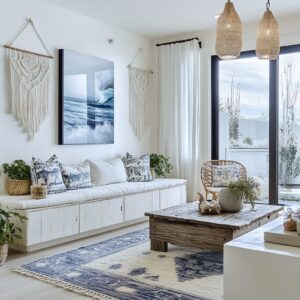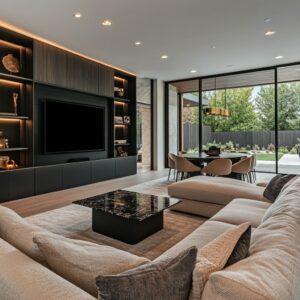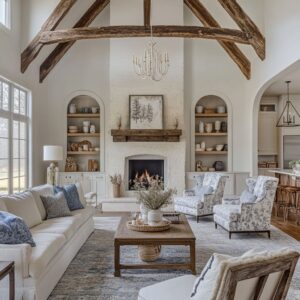Modern interpretations of Mexican living room decorating ideas are quietly reshaping homes across many regions, blending handmade textures, sculptural architecture, and sun-warmed palettes into spaces that feel both grounded and timeless. This style doesn’t shout through color or ornamentation; instead, it builds atmosphere through soft plaster walls, natural stone, raw wood, and carefully placed artisan pieces.
The newest Mexican-inspired spaces favor restraint over repetition, highlighting the beauty of negative space, subtle material shifts, and the natural movement of light across textured surfaces. Massive pottery, woven lighting, and layered flat-weave rugs create tactile depth without crowding the rooms.
Simple forms—like blocky travertine tables or low-slung linen sofas—anchor interiors while leaving plenty of room for air and quiet shadow.
Across a range of house types, from suburban bungalows to open desert ranch homes, the approach adapts effortlessly, integrating classic elements like arches, vigas, and cantera stone with the needs of contemporary open layouts. Throughout it all, the mood stays tied to nature—both in the materials used and the rhythms they suggest—with every surface inviting a closer look and a slower pace.
Core Architectural Moves
One of the strongest signatures in Mexican living room ideas today is the way technology and structure melt quietly into the architecture itself. Instead of treating TVs, shelves, and benches as added furniture, designers often carve them directly into thick plastered walls.
These soft-edged masses create calm, weighty shapes that feel hand-built, blending into the space like they have always been part of it. With no sharp breaks or clunky lines, the whole room breathes easier, and every object placed against these surfaces feels intentionally framed.
Ceiling design plays its role too, borrowing from historical influences but adjusting them to suit suburban homes and smaller spaces. Timber beams, whether solid or faux, stretch across ceilings but are spaced farther apart than in old haciendas, and lighter stains are favored.
The wood adds depth without dragging the atmosphere down, keeping the room spacious and full of air.
Arches continue to be a clear mark of Spanish-Mexican heritage, yet the best Mexican-inspired living room spaces use them sparingly. A single rounded window, a softly curved fireplace opening, or one smooth passageway is often enough to capture the spirit.
By resisting the temptation to overuse the form, designers keep the look strong, timeless, and refreshingly uncluttered.
Material Logic
The surfaces in a fresh Mexican living room rarely shout for attention but reward anyone who looks closely. Traditional flat paints are often replaced with limewash, clay plaster, or microcement finishes.
These materials don’t just look good; they bring soft motion to the walls, regulate humidity naturally, and hide small imperfections over time. Whether on the humid coasts or in the high desert areas, these finishes adapt beautifully to the environment while adding a quiet richness to the room.
Stone plays an equally grounded part. Whether it’s local limestone, rough cantera, or handmade bleached brick, the surfaces are left raw enough to show their history.
Fossil traces, uneven textures, and soft color shifts stay visible, making every wall or hearth feel connected to the earth it came from. The emphasis remains on celebrating the natural character of each stone without heavy polishes or high gloss.
Furnishing choices echo this deep respect for raw material. Tables tend to be low, heavy, and organic—live-edge mesquite slabs, blocky travertine pieces, or hand-chiseled volcanic stone that seems to rise naturally from the floor.
Their weight at ground level anchors the entire seating arrangement, creating a solid counterbalance to the lightness of the plastered walls and the open air above.
Colour Temperatures
The modern Mexican living room often feels like it has pulled its palette directly from the desert floor and the open sky. Rather than layering stark contrasts, the color base leans into ground-heat neutrals: shades like sand, bone, clay beige, and muted apricot build a soft, warm backdrop.
These tones catch natural light gently, making rooms glow instead of glare. Cooler notes—such as sage, soft cactus green, and pale teal—appear only in small accents, nodding to the dusty greens of native plants without overpowering the warmth.
Instead of hard borders between colors, designers favor subtle shifts. In many homes, the walls are tinted in faint micro-gradients—starting pale near the baseboards and deepening ever so slightly as the plaster rises toward the ceiling.
This gentle vertical transition gives the room quiet movement without the visual heaviness of stripes.
Adding a sense of life to the dusty base, each Mexican theme living room tends to feature just one vivid textile: a handwoven Zapotec runner, a rose-madder rug, or perhaps a pair of paprika-colored pillows. Rather than layering many bright objects, this single hit of saturated color stands out like a piece of functional art against the otherwise sun-faded environment.
Furniture Form & Height
Furniture in Mexican-influenced spaces understands how to stay grounded—both literally and visually. Built-in benches, blocky coffee tables, and low-profile sofas keep the centre of gravity close to the floor.
This quiet design move stretches sightlines horizontally, making rooms feel broader and more connected to the landscape outside, where desert views often run uninterrupted to the horizon.
The shapes within these spaces are typically squared and strong, but they don’t feel severe. Sling chairs crafted from saddle leather, corduroy throw cushions, and ribbed linen fabrics introduce texture that softens the strict geometry without resorting to heavy curves.
The balance between hard line and soft weave keeps the layout feeling composed and touchable at the same time.
Adaptability is also built right into the furniture plans. Many sectionals are modular, with detached ottomans or chaise modules that can shift with daily life.
What’s important is that the wheels and clips stay hidden, preserving the room’s calm appearance. These subtle design choices reflect the way modern families live now, allowing a room to stay beautiful even as it changes shape throughout the day.
Handmade Layers
One of the quiet strengths of a modern Mexican living room is the way it leans into handmade textures without overwhelming the space. Instead of filling shelves with many small objects, the focus shifts to using just two or three oversized clay vessels within a single vignette.
This controlled tension between the larger object scale and the minimal count gives the eye room to rest, keeping displays thoughtful rather than crowded.
Lighting choices also carry this crafted spirit. Rather than ornate fixtures, palm, maguey, and reed pendants often drop low, acting as quiet sculptures within the space.
These pieces create patterned shadows that move gently across plastered walls and floors, echoing the weave of traditional textiles without needing to introduce extra color.
Underfoot, the layering story continues. A base of rough jute or flat-weave wool provides durability against heavy foot traffic, while a second, finer artisan-made rug sits above, offering texture that feels good under bare feet.
Besides adding richness, this layered approach cleverly conceals any floor outlets or cords, reducing the need for extra tables just to support lighting. The overall effect feels effortless, grounded, and fully connected to the slow craft traditions that shape authentic Mexican living room ideas today.
Technology Camouflage
Technology finds its place in a Mexican theme living room by blending into the architecture instead of standing apart from it. One of the most effective techniques is recessing televisions a few inches deeper than the surrounding surface, whether it’s stone, plaster, or artisan tile.
By finishing the edge with the same material as the wall, the black glass of the screen feels more like a framed artwork than an intrusive modern object.
Where media cabinetry is necessary, the approach stays simple and integrated. Instead of bulky entertainment centers, designers create bench-height ledges using driftwood planks, bleached oak, or smooth stone slabs.
These elements sit low along the wall, freeing the space above for light, texture, or the soft shifts of plastered surfaces. By keeping furniture lines subtle and materials honest, the rooms maintain their calm balance between modern comfort and deeply rooted handmade character.
Light Management
In thoughtful Mexican living room decor, natural light always takes priority over artificial sources. Expansive windows and softly arched doorways are intentionally positioned to frame outdoor views—whether it’s a stand of cactus, rolling canyon ridges, or sun-warmed stone gardens.
These openings become part of the room’s visual language, pulling the outside in. Artificial light, when added, arrives carefully: often as a single handcrafted pendant or through hidden LED strips tucked into wall niches.
Ceilings stay pure, free from cluttered grids of recessed lights, allowing plaster finishes and timber beams to remain undisturbed.
Managing sunlight inside relies more on filtering than blocking. Roman shades woven from palm fibre, loose linen curtains, and handwoven screens all help modulate the glare while keeping interiors glowing softly.
The focus stays on creating muted brightness, not on casting the space into heavy darkness. Texture plays a starring role in this balance, allowing rooms to feel fresh and breathable throughout the day.
Design Insights
Modern Mexican style living room ideas show how skillfully absence can be used as a design tool. Negative space acts almost like an ornament itself: shelves spaced widely, coffee tables purposefully left half-clear, and single oversized clay vessels standing alone on large wall planes.
This breathing room brings stronger focus to the handmade and the imperfect, giving craftsmanship the space it deserves.
Rather than adding accent walls with color, texture takes the lead vertically. Raised-relief tiles, carefully stacked stone, and artisanal woven panels stretch from floor to ceiling, subtly pulling the eye upward.
This quiet use of tactile stripes helps smaller spaces feel taller without shouting for attention.
Lighting follows the same restrained spirit. Hidden slots under plaster benches or tucked behind architectural edges hold soft LED ribbons that light up pottery collections and wall textures from below.
These hidden sources recreate the warmth of old courtyard lanterns without visibly revealing their origin.
Temperature control blends seamlessly into the design language too. Materials like clay, sand, and limestone are not selected only for their beauty but for their natural thermal properties—absorbing daytime heat and releasing it slowly as temperatures drop.
This choice deepens the authenticity of the rooms while quietly supporting comfort.
Furniture choices echo the surrounding landforms. Thick travertine blocks and rough volcanic stone tables are placed on pale woven rugs, isolating their heavy, grounded forms against soft backgrounds.
In these settings, tables feel less like furnishings and more like abstracted slices of the local geography, deepening the physical and emotional ties between house and environment.
Interesting Pairings
| Goal | Material Mix | Colour Notes | Furnishing Tip |
|---|---|---|---|
| Amplify small footprint | Clay plaster + micro-scale artisan tile inset | Single soft neutral across walls & ceiling | Use one monolithic coffee block; keep sofa legs invisible |
| Soften modern glass box | Cantera stone hearth + woven reed pendant | Bone plaster with pale sage accent pillows | Insert driftwood media console to warm glass surfaces |
| Blend suburban setting with desert cues | Bleached brick feature wall + jute over concrete floor | Dusty rose brick, bone sofa, paprika rug | Add one cactus in oversized clay urn to echo color family |
| Honor crafts without clutter | Floating oak shelf + three monumental pots | Sand plaster, muted olive accents | Skip side tables; use wide arm sofa arms as perch for books |
| Push texture in humid coastal zone | Limewash apricot walls + palm fibre shade | Terracotta and light peach textiles | Stone coffee table left unpolished to resist salt air |




























